One of the things Ka-Voka Jackson, the cultural resources director of the Hualapai Nation, most appreciates about Ha’Kamwe’ is its peacefulness. Located on a former ranch in western Arizona, the hot spring is framed by rolling desert hills. Though trucks may sometimes drive down a nearby dirt road, it’s mostly quiet. That serenity is an important part of Hualapai cultural practices that have taken place here for millennia, from gathering plants to holding ceremonies.
“When we visit and we look across the landscape, that’s the same landscape that our ancestors looked at and that our ancestors lived in, and so we hold a deep connection with the integrity of that landscape,” Jackson said.
But amid the green energy boom, Ha’Kamwe’ is threatened by lithium exploration by the Australia-based company Arizona Lithium, or AZL, and these days, peace seems elusive. Already, the mining company has drilled approximately 50 exploratory wells near the hot springs, disturbing the tribe’s cultural practices and threatening the aquifer. Since 2021, when High Country News first covered the threat that this drilling poses to Hualapai religious practices, the Bureau of Land Management, or BLM, has signed off on even more drilling near Ha’Kamwe’. This July, the BLM approved AZL’s plan to bore approximately 130 more wells near the hot spring, reaching more than 300 feet deep and surrounding the hot spring on three sides. AZL will construct drill pads sites, roads, and other support infrastructure as it surveys the area further for a potential open-pit lithium mine.
On August 8, the Hualapai Nation sued the BLM and the Department of the Interior. According to the lawsuit, the agencies violated multiple laws, including the National Environmental Policy Act and the National Historic Preservation Act, in approving this new phase of exploratory mining. Since September, AZL has been under a temporary restraining order to prevent further drilling.
Now, a district judge in Phoenix is deciding whether to grant a preliminary injunction to stop further lithium exploration for the duration of the court case. U.S. District Judge Diane J. Humetewa heard the request for a preliminary junction on September 16. Until her decision, the temporary restraining order will remain in place. As of press time, a decision had not been made.
If the judge does not grant the injunction, Jackson said, “it would interfere with our ability to hold ceremony and just experience a place as Hualapai people on that land. We want the [drilling] ban, because that would allow us to continue with our lawsuit against the Bureau of Land Management, without having to worry about further damage to the site.”
Without the preliminary injunction, the exploratory drilling could be completed before the court case against it, according to Laura Berglan, a lawyer with Earthjustice who is representing the Hualapai in court. ”And then what’s the tribe’s remedy at that juncture, if that’s the case?” she said. “There’s really nothing that can be done. It will just be a win on paper.”
Ha’Kamwe’ qualifies for cultural resources protection under the National Historic Preservation Act, or NHPA. One of the main complaints in the tribe’s lawsuit is that the BLM violated the law when it approved the additional drilling in July by simply excluding the spring from the area it studied for potential impacts and despite the Hualapai Tribe’s letters asking the agency to include Ha’Kamwe’ in its NHPA evaluations. The BLM also disregarded letters from the federal Advisory Council on Historic Preservation warning that AZL’s exploratory drilling could violate the NHPA by threatening cultural practices at Ha’Kamwe’ with its noise, vibrations, and other disturbances.
According to John Welch, vice president for preservation and collaboration at the nonprofit Archaeology Southwest, the BLM excluded “a bona fide historic property and traditional cultural property to bound the area of potential effects — which is exactly what you’re not supposed to do.” The BLM, he said, should have considered the impacts that drilling near the spring would have on the cultural practices that take place there.
The BLM also did not consider compromise options, such as moving the drill sites farther away from Ha’Kamwe’, for example, or approving fewer of them, which the tribe says violated the National Environmental Protection Act, or NEPA.
Another major issue of contention is whether the BLM adequately studied the potential impacts of exploratory drilling on the spring’s flow, as required by NEPA. The agency relied on a 24-year-old hydrological study conducted for a different project in a nearby location. The BLM concluded that the aquifer that feeds Ha’Kamwe’ was too deep to be punctured by drilling.
“The BLM refused to take a hard look at the water and hydrology,” Jackson said. “We wanted them to do a field study. Show us it’s not going to impact the water, don’t just rely on old studies to say there will be no impact.” The tribe’s own hydrological research found that the groundwater could easily be disturbed by exploratory drilling, and that drilling would likely disrupt H’Kamwe’. The tribe shared its concerns with the BLM in March, but the agency stuck to its conclusion that the water feeding the spring was too deep to be impacted.
In an unusual move, Arizona Attorney General Kristin Mayes jumped in to support the preliminary injunction that the judge will soon be ruling on, citing concerns about the region’s water supply. According to Mayes’ brief, the BLM used “stale data” when it approved continued lithium exploration near Ha’Kamwe’. But the tribe’s more recent hydrological research shows that the drilling is likely to damage the hot spring — possibly even “dewatering” Ha’Kamwe’. Mayes also concluded it’s not really clear how, in the moment, the mining company might plug a borehole that punctured the aquifer — in fact, she contends that the company already has failed to “properly cap and abandon” the holes it previously drilled near Ha’Kamwe’.
“If the tribe is correct, issuance of a preliminary injunction now is the only way to avoid irreparable and catastrophic harm” to Ha’Kamwe’, the attorney general wrote.
The tribe has already reported changes: The water level at Ha’Kamwe’ has increased during the past month, and more and more air bubbles are churning up through the water. Equally concerning are the fissures that have opened in the ground nearby. Although the Hualapai can’t conclusively connect those changes to the mineral exploration without further study, the fact that they happened so close to the most recent exploratory drilling is worrying.
In its response to the tribe’s request for a preliminary injunction, AZL maintained that the older hydrological report that the BLM referenced was correct, and that the exploratory drilling does not threaten Ha’Kamwe’. AZL also pointed out that so far none of the drilling has hit water.
As of this writing, the BLM has not responded to repeated requests for comment from High Country News about the preliminary injunction. HCN also reached out unsuccessfully to Thorpe Shwer P.C., the law firm representing Arizona Lithium, and to Paul Lloyd at Arizona Lithium.
For now, until the judge makes her ruling, a temporary encampment has sprung up at Ha’Kamwe’. Hualapai people and their supporters are keeping watch and praying. Even if the preliminary injunction is not granted, Jackson said, the tribe will continue fighting to protect Ha’Kamwe’.
Jackson said that the Hualapai Nation is not against green energy. But she noted that green energy projects typically come at the expense of tribal communities and rural communities.
“We’re trying to stand up for ourselves and say, ‘You’re affecting us. You’re affecting our connection to the area. You’re destroying our history, and we’re Indigenous to this land, and these are one of the few places that we have left and that we’re trying to protect,’” she said. “Especially coming from a foreign company like Arizona Lithium — you can’t just come and continue to destroy and take away from us. We’re not going to sit there quietly and let that happen.”
Source link
Maya L. Kapoor grist.org



